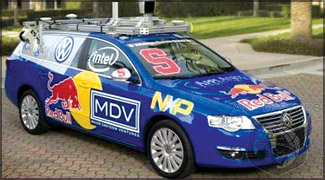 The
expanding world of robots The
expanding world of robots
The world of robots is always fascinating. We featured many robots,
including humanoids, in our earlier issues. Today, we are featuring a
few more to improve your knowledge about the latest and more fascinating
robots. If you find information about any more robots, feel free to
share it with us.
***
Keepon, the dancing robot
 Keepon
is a small yellow robot designed to perform emotive (involving emotions)
and attentive exchange with human interactions (especially children) in
the simplest and most comprehensive way. This is one of the most popular
robots to come out during the past year. Since it is not available for
sale, the videos of Keepon are very popular among people. Keepon
is a small yellow robot designed to perform emotive (involving emotions)
and attentive exchange with human interactions (especially children) in
the simplest and most comprehensive way. This is one of the most popular
robots to come out during the past year. Since it is not available for
sale, the videos of Keepon are very popular among people.
Hideki Kozima of the National Institute of Information and
Communications Technology in Kyoto, Japan developed Keepon. The robot
has four motors, a rubber skin, two cameras for eyes and a microphone in
its mouth. In appearance, it resembles a yellow snowman or a chick.
Keepon is used to study the underlying mechanisms of social
communication. Its simple appearance and actions make it possible for
infants and children as well as adults to interact with it.
The robot, usually under the control of a teleoperator, interacts
with children in schools and remedial centres for developmental
disorders.
The small robot was depicted dancing to the song 'I Turn My Camera
On' by the band Spoon. More recently, Keepon has been featured in the
official music video for Spoon's single 'Don't You Evah.'
****
Stanley, the robot vehicle
Stanley is an autonomous (self-controlling) vehicle created by
Stanford University's Stanford Racing Team in co-operation with the
Volkswagen Electronics Research Laboratory (ERL). This is one of the
best robots invented in the world so far.
 It
competed in, and won, the 2005 Defense Advanced Research Projects Agency
(DARPA) Grand Challenge, earning the Stanford Racing Team the two
million dollar prize, the largest prize money in robotic history. It
competed in, and won, the 2005 Defense Advanced Research Projects Agency
(DARPA) Grand Challenge, earning the Stanford Racing Team the two
million dollar prize, the largest prize money in robotic history.
Led by Associate Professor Sebastian Thrun, director of the Stanford
Artificial Intelligence Lab, the Stanford Racing Team was developed
solely for competing in the 2005 DARPA Grand Challenge. Stanford did not
participate in the DARPA Grand Challenge in 2004. It was considered to
have a 20:1 chance of winning the 2005 competition.
Stanley is currently located at a garage near the university. It was
displayed at the 2006 New York International Auto Show at the
Smithsonian Museum (USA), and will be spending two years at the
Volkswagen Autostadt Museum (Germany) before returning indefinitely to
the Smithsonian Museum.
The Stanford Racing Team has entered a new vehicle, a modified
Volkswagen Passat wagon, dubbed 'Junior', in the 2007 DARPA Urban
Challenge. Other key contributors on the team include Michael Montemerlo
(software lead), Sven Strohband (lead engineer) Cedric Dupont (vehicle
lead), and Pamela Mahoney (communications lead).
Stanley's original frame was a standard European diesel model
Volkswagen Touareg provided by Volkswagen's ERL for the competition.
Stanley had sensors installed in a wheel to record a pattern imprinted
on the tyre and to act as an odometer (a device built in a vehicle that
records the distance travelled).
This is used in case of loss of signal (such as when driving through
a tunnel); using this sensor and its data, the on-board computer can
estimate how far it has travelled since the signal was lost.
****
Aibo, the robot pet
AIBO (Artificial Intelligence roBOt, equal to 'companion' in
Japanese) is one of several types of robotic pets designed and
manufactured by Sony; there have been several different models since
their introduction in 1999.
 Able
to walk, 'see' its environment via camera, and recognise spoken
commands, they are considered autonomous robots, since they are able to
learn and mature based on external incentives from their owner or
environment, or from other AIBOs. Artist Hajime Sorayama created the
initial designs for the AIBO. Able
to walk, 'see' its environment via camera, and recognise spoken
commands, they are considered autonomous robots, since they are able to
learn and mature based on external incentives from their owner or
environment, or from other AIBOs. Artist Hajime Sorayama created the
initial designs for the AIBO.
The AIBO has been used as an inexpensive platform for artificial
intelligence research, because it integrates a computer, vision system,
and articulators in a package vastly cheaper than conventional research
robots.
The Robocop autonomous soccer competition has a Robocop Four-Legged
Robot Soccer League in which numerous institutions from around the world
participate. Competitors programme a team of AIBO robots to play games
of autonomous robot soccer against other competing teams.
The newest versions of AIBO are equipped with a Wi-Fi connection,
allowing them to send the pictures they take via email. AIBO's sounds
were programmed by Japanese DJ/futuristic composer Nobukazu Takemura,
who is considered by many to be highly skilled at mixing mechanic and
organic concepts, and the bodies of the '3x' series (Latte and Macaron,
the round-headed AIBOs released in 2001) were designed by visual artist
Katsura Moshino.
Compiled by Janani Amarasekara |
